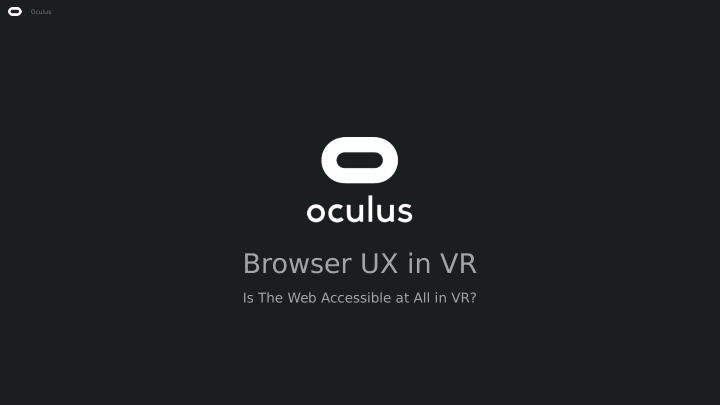



Oculus Browser UX in VR Is The Web Accessible at All in VR?
Oculus Overview • Virtual Desktop & Browser VR Apps Have Long Engagement Times – How? Did they do something special? • Uncomfortable Yet Still Compelling Content • High Quality Reprojection • Nail Input • Design for Security and Trust • Redesign for the VR Medium
Oculus 2D Content Reprojection • High Quality 2D Content Surface Rendering & Reprojection – Text, text, text – Cylinder Surfaces, Custom Projections • Wrapped in a VR UI – Positioned for Head Comfort – Mobile Panel-like Designs – Big Hit-Targets • Careful Management of Viewport Characteristics – Mobiles Sizes + Responsive Web Design
Oculus Rethinking User Input Models • Most Inputs Can be Resolved w/ Gaze – Gaze & Hold, Gaze & Press, Inertial Gaze – Big Hit-Targets (new content) – Hit-Target Attraction – Shape Based Hit-Testing (legacy content) • Link Disambiguation UX – The Craigslist Test – Aka Gaze Clarification
Oculus Rethinking User Input Models • Voice Commanding – Redesigned Simplified UX Ideal for Voice Commands – Assistant Based Voice Models Reduce Keyboard Reliance • Predictive and Context Aware Keyboards – Complex Key Based Input Won’t be Eliminated – Improved Context Detection for Web Inputs
Oculus User Trust & Security • Theme: Securely Execute a Login and Transaction in VR • Guaranteed Trust Model against UI Spoofing – Transport is Secure and Valid – Domain Taking User Data is Clearly Identifiable • Gaze, Voice, Gamepad, Can be Secured to a target Context • Integrate Existing Solutions – Password Management and FIDO – Form Filling – Web Payments API
Recommend
More recommend